Links.....
.
.
.
.
.
.
.
.
.
.
.
.
.
.
.
.
.
.
.
.
.
.
.
.
.
.
.
.
.
.
.
.
.
.
.
.
.
.
.
.
.
.
.
.
.
.
.
.
.
.
.
.
.
.
.
.
.
.
.
.
.
.
.
.
.
.
.
April 17th 2005 - 70th Anniversary of the first Pan American Airways flight from Alameda, California to Honolulu, Hawai'i.
Three stamps and a mini-sheet were issued on April 17th 2005 to celebrate the 70th Anniversary of the first Pan American Airways flight from Alameda, California to Honolulu, Hawai'i.
Founded in 1927 by Juan Trippe (photo below left), Pan American Airways was a trail-blazing pioneer in commercial aviation. It was the first American airline to operate a permanent international air service on October 27 1927 from Key West, Florida to Havana, Cuba using a Tri-motor Fokker F-7. The Sikorsky S-42 four-engined flying boat was introduced in August 1934 at a cost of $242,000. It was then the largest aircraft ever built in the U.S.A., with a length of 69 feet and a wing span of 114 feet. The plane was powered by four Pratt & Whitney Hornet engines. With this plane in 1935, Pan Am became the first airline to operate scheduled trans-Pacific passenger and airmail service.
 . .
. . 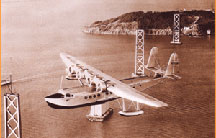
On April 16 1935, the first Trans-Pacific Survey Flight Number 1 by Pan American Airways took off from Alameda, California. The photo, above right, shows the plane passing over the Oakland Bay Bridge (under construction at that time). The plane was a Sikorsky S-42 NR 823M, called "Pan American Clipper" (formerly "West Indies Clipper" used in Latin America from December 1934). The non-stop flight lasted for 18 hours and 37 minutes. Upon arrival in Honolulu at 8a.m. on April 17 1935, the 6-man crew received a big aloha welcome at Ford Island. (Ford Island was Pan-Am's base of flying boat operations until October 1935, when it was moved across Pearl Harbor to the Pearl City base). The crew consisted of Captain Edwin Musick; First Officer, R.O.D. Sullivan; Engineering Officer, Victor Wright; Navigator, Fred Noonan; Radio Officer, W.Jarboe Jr.; and Junior Officer, Harry Canaday. Captain Edwin Musick died in the crash of the "Samoan Clipper" in January 1938, along with the crew, near Tutuila Island, American Samoa.
Click here to view a silent black-and-white newsreel from the 1930's which includes the arrival of the 1935 "Pan American Clipper" in Hawai'i.
This particular plane was renamed "Hong Kong Clipper" in 1937. It sank at Antilla, Cuba on August 7 1944. Later flights to Hawai'i used the Martin M-130 and were named "Hawaii Clipper", "Philippine Clipper" and "China Clipper". Boeing B-314's introduced on this route in 1939 included "Honolulu Clipper", "California Clipper", "Pacific Clipper" and "Anzac Clipper".
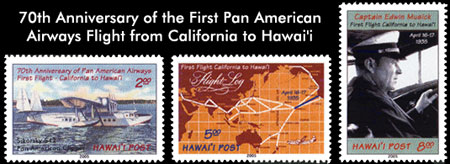
The $2 stamp (above left) pays for extra charges, such as additional weight. It shows the Sikorsky S42 "Pan American Clipper" on water.
The $5 stamp (above middle) prepays the Overnight rate. It comes from an original postcard published by Pan-Am and shows a map of the world and Pan-Am's Clipper routes. The flight commemorated by this issue is shown in blue.
The $8 stamp (above right) prepays the Same Day rate. It shows a portrait of Captain Edwin Musick, the pilot of this flight.
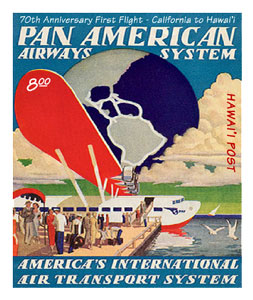
The $8 mini-sheet (above) prepays the Same Day rate. It shows a colorful art-deco poster originally drawn for Pan American Airways in the 1930's. It promoted their Clipper flying boats to South America. It shows passengers boarding a Boeing B-314 flying boat at a dock on a lagoon somewhere in the world. After the clippers, Pan-Am used more economical land-based aircraft. Until it's demise, Pan-Am was one of the airlines that helped the dramatic development of Hawai'i as a tourist destination.
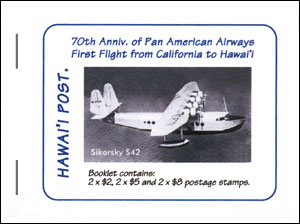
A Booklet consisting of 3 panes containing 2 x $2, 2 x $5 and 2 x $8 stamps was also issued. Each pane consists of 2 stamps and has a white margin all around. "© 2005 Hawai'i Post" is printed vertically on the lower right side margin & Hawai'i Security Printers, Honolulu, Hawai'i. is printed on the bottom margin of each pane. The booklet cover is of white card stock and is stapled twice at the left side. The booklet cover shows a photo of the plane used in the flight, the Sikorsky S42.The back cover explains the postage rates of Hawai'i Post.
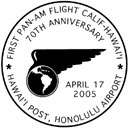
The postmark for this issue shows the original logo of Pan-American Airways which was used from 1928. The letters PAA were added to the inside of the logo in 1944.
Click here to order the stamps.
WE ACCEPT CREDIT CARDS ON ALL ORDERS
![]()
![]()
![]()
![]()
Technical details of the stamps and mini-sheet:
Colors: Multicolored.
Size: Stamps - 48mm x 32mm. Mini-sheet - 76mm x 70mm.
Stamp sheet size: 30. $2 & $5 (5 across, 6 down), $8 (6 across, 5 down).
Perforation: 12. Mini-sheet - imperforate.
Stamp design: Enelani.
Layout & Pre-press: Enelani.
Printer: Hawai'i Security Printers, Honolulu, Hawai'i.
Printing Method: 4-color (Cyan, Magenta, Yellow and Black).
Sheet margin markings: HAWAI'I POST (top middle), "Traffic Light" showing 5 colors used in printing (lower left side), © 2005 Hawai'i Post (lower right side) & Hawai'i Security Printers, Honolulu, Hawai'i. (bottom middle)
Paper: GPA coated white stock with water-activated gum on the back.
Return to list of stamp issues
For details on upcoming stamp issues click here